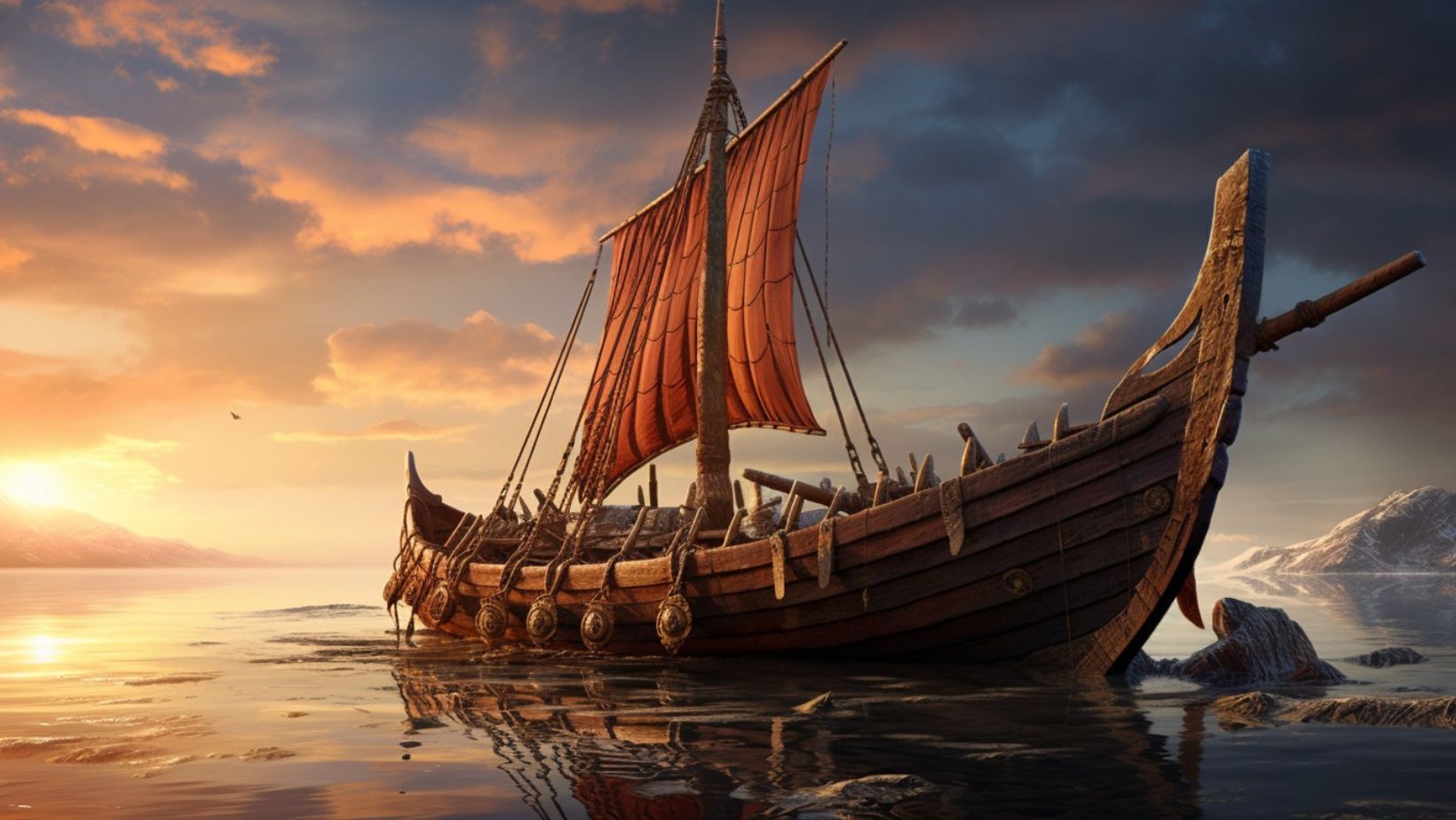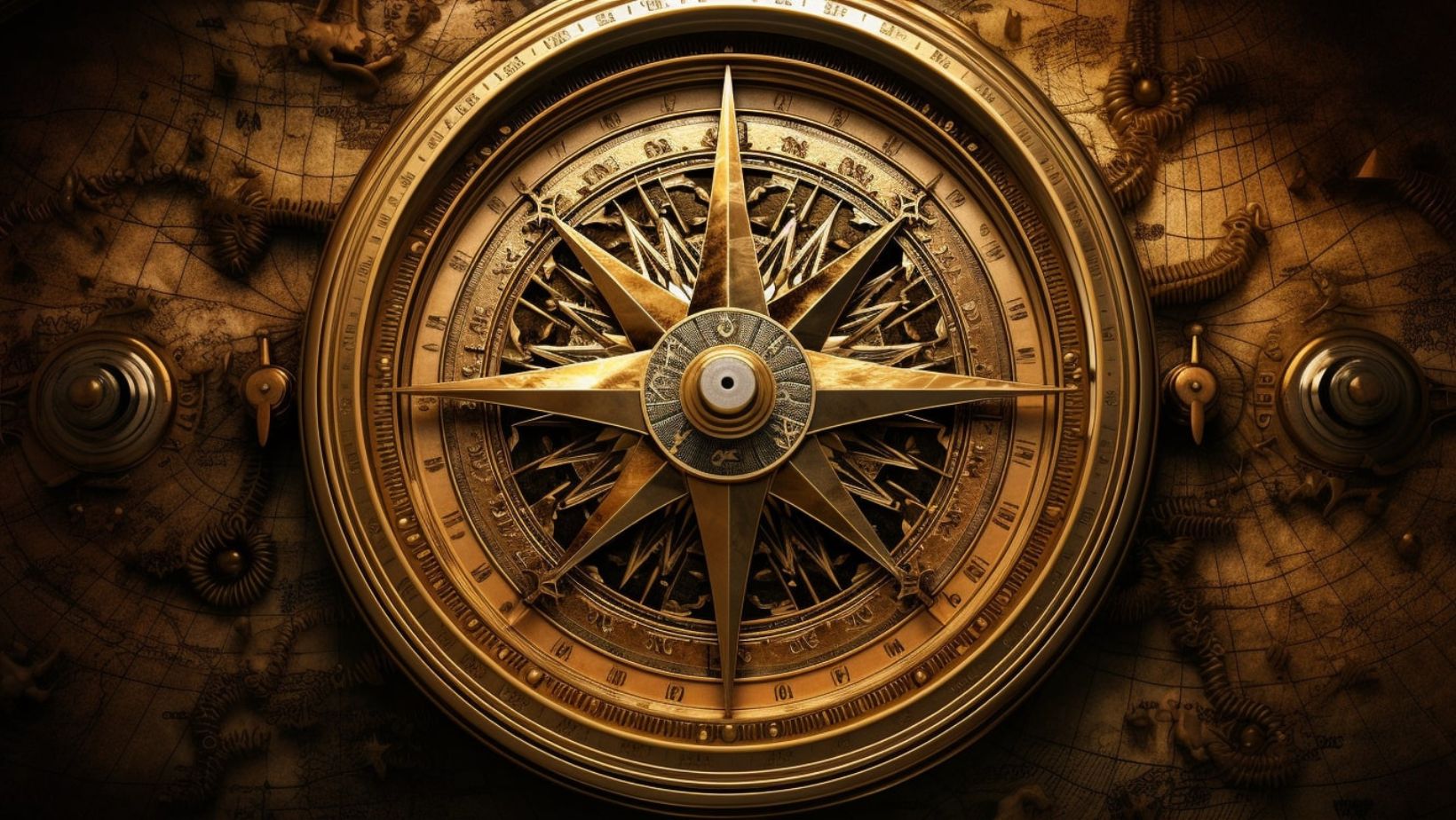Dive into the world of Viking maritime navigation, where seafaring skills were as crucial as swords and shields. The Vikings were not just fierce raiders; they were also master navigators who explored and charted unknown waters. Their ability to sail vast distances was essential for their raids, trade, and discovery of new lands.
Maritime navigation was critical to their success, enabling them to reach places like Iceland and Greenland. Are you curious about how these ancient explorers mastered the seas? Let’s uncover the techniques and tools that made Viking navigation legendary.
The Viking Longship: A Key to Viking Maritime Navigation

The Viking longship was a marvel of ancient maritime design, crucial for their navigation and exploration. Its sleek, narrow hull allowed it to cut through water quickly and efficiently, essential for both raiding and long voyages. The ship’s shallow draft enabled it to navigate shallow waters and rivers, making it versatile for coastal and inland travel. Longships were also built with a flexible keel, which improved stability and maneuverability in rough seas.
This design was vital for Viking exploration. Longships allowed Vikings to venture far beyond their Scandinavian homeland, reaching places like Iceland, Greenland, and even North America. Their ability to travel long distances and explore new territories was directly tied to the longship’s advanced construction. The ship’s speed and agility made it a key tool for their maritime navigation, enabling the Vikings to chart unknown waters and establish distant settlements.
Tools and Techniques for Navigating the Seas
Vikings relied on a combination of sophisticated tools and techniques to navigate the vast and often treacherous seas. Their methods were advanced for their time, allowing them to travel long distances with remarkable accuracy.
Sun Compasses and Star Charts
The Vikings used several tools for maritime navigation, including sun compasses and star charts. The sun compass helped them determine their direction during daylight by tracking the position of the sun. Star charts and the use of the North Star allowed them to navigate at night, providing a reliable reference point. These tools were essential for maintaining course over long voyages.
Landmarks and Coastal Viking Maritime Navigation
Landmarks played a crucial role in Viking navigation, especially when close to shore. They used distinctive coastal features like cliffs, bays, and islands to guide their way. This method, known as coastal navigation, involved memorizing key landmarks and using them to plot their course. The combination of these visual cues with their navigational tools ensured that Vikings could travel efficiently and safely, even across unknown waters.
The Viking Knowledge of Celestial Viking Maritime Navigation
Vikings were skilled in celestial navigation, using the sun and stars to guide their voyages. During the day, they tracked the sun’s position to determine direction. By noting the sun’s height and movement, they could maintain a steady course. At night, they used the stars, especially the North Star, Polaris, to find their way, relying on its fixed position in the sky.
A crucial tool in Viking navigation was the “sunstone.” This mineral, also known as a polarizing crystal, helped Vikings locate the sun’s position even on cloudy days. The sunstone could polarize light, allowing sailors to determine the sun’s direction and thus maintain their course. By combining these techniques, Vikings effectively navigated vast distances across the open seas.
Reading the Sea: Weather Patterns and Ocean Currents
Vikings were adept at interpreting weather patterns to aid their navigation. They observed changes in wind direction, cloud formations, and sea conditions to predict the weather. For example, the appearance of certain cloud types or the color of the sea could indicate upcoming storms or calm periods. This knowledge allowed them to plan their voyages and avoid hazardous conditions.
Understanding ocean currents was equally important for Viking navigation. They knew that currents could significantly affect their course and speed. By studying the flow of water and its effects on their ships, they could use these currents to their advantage or adjust their route as needed. This expertise in reading both weather patterns and ocean currents ensured that Vikings could navigate efficiently and safely across the vast and unpredictable seas.
The Role of Oral Tradition in Viking Maritime Navigation
Oral tradition played a crucial role in preserving Viking navigational knowledge. Since written records were scarce, Viking sailors relied on stories and songs to pass down important information. These oral accounts included detailed descriptions of sea routes, landmarks, and navigational techniques. By memorizing and reciting these stories, new generations of sailors could learn and retain essential navigational skills.
These oral traditions also helped maintain and refine navigation practices over time. Elders and experienced navigators shared their knowledge with younger sailors through storytelling, ensuring that techniques and wisdom were not lost. This method of learning was effective in preserving a rich body of maritime expertise and adapting it to discoveries. The continued use of oral tradition allowed Viking maritime skills to evolve and endure throughout the Viking Age.
Viking Exploration Routes and Discoveries

Vikings charted major exploration routes that extended across Europe and beyond. They traveled through the Baltic Sea, navigating rivers like the Dnieper and Volga to reach Byzantine and Arab markets. Their longships also sailed the North Atlantic, leading to significant discoveries. The Vikings reached Iceland around 870 AD, Greenland by 980 AD, and even ventured to North America, landing in Newfoundland around 1000 AD.
These discoveries had a profound impact on Viking and world history. Iceland and Greenland became significant Viking settlements, influencing the culture and economy of the North Atlantic region. Though short-lived, exploration of North America showcased Viking maritime prowess and expanded the known world. These routes and discoveries demonstrated Viking navigational skills and paved the way for future exploration and trade.
The Influence of Norse Mythology on Viking Maritime Navigation
Norse mythology profoundly influenced Viking navigation and exploration. Mythological references often provided guidance and inspiration for voyages. For example, the god Odin was associated with wisdom and guidance, qualities that were vital for successful navigation. Mythological stories about the world tree, Yggdrasil, and its branches, which connected different realms, symbolically represented the Vikings’ understanding of their world and navigational ambitions. Viking Maritime Navigation.
Mythology also shaped practical navigational practices. The Vikings believed that gods and supernatural beings could protect or guide them on their journeys. Rituals and offerings were made to appease these deities, ensuring safe travels. This belief system integrated with their practical knowledge of navigation, combining spiritual and practical elements to enhance their maritime skills and encourage exploration.
Challenges and Solutions in Viking Navigation
Vikings faced several navigational challenges during their seafaring expeditions. One major challenge was the unpredictable weather, including fog, storms, and rough seas, which made navigation difficult. The lack of accurate maps and charts also posed significant difficulties in finding and maintaining a course and additionally, navigating unfamiliar waters and finding safe harbors required skill and experience.
To overcome these challenges, Vikings developed several innovative solutions. They used tools like sun compasses and sunstone to determine their direction even in poor visibility. Skilled sailors relied on landmarks and coastal navigation to guide them through known waters. Furthermore, their deep knowledge of weather patterns and ocean currents allowed them to anticipate and adapt to changing conditions. These innovations and adaptations helped Vikings navigate vast distances and successfully explore new lands.
Legacy of Viking Maritime Navigation Techniques

Viking navigation techniques had a lasting influence on later maritime practices. Their methods, such as using celestial bodies and natural landmarks, set the foundation for navigational skills in subsequent centuries. Early explorers and sailors adopted these techniques, adapting them to new technologies and improved maps. Viking innovations in shipbuilding and navigation significantly impacted the development of maritime exploration.
The legacy of Viking navigation is still evident in modern navigation. Techniques like celestial navigation, once pioneered by the Vikings, remain a backup system in contemporary maritime navigation. The principles of using natural cues for direction and understanding ocean currents remain fundamental to navigation. Viking contributions laid the groundwork for future explorers, influencing how we traverse and understand the seas today. Viking Maritime Navigation.
Conclusion: The Mastery of Viking Maritime Navigation
The Vikings mastered maritime navigation through advanced techniques and practical tools. Using sun compasses, star charts, and innovative sunstone allowed them to navigate vast distances. They skillfully interpreted weather patterns and ocean currents, and oral traditions preserved vital navigational knowledge. These practices facilitated their exploration and left a lasting impact on maritime navigation.
Reflecting on their achievements highlights the extraordinary skill and ingenuity of Viking navigators, whose methods laid the groundwork for future exploration and continue to influence modern navigation.
FAQs About Viking Maritime Navigation
How did Vikings navigate in foggy or overcast conditions?
Vikings used the sunstone, a special crystal, to find the sun’s direction even when clouds obscured it. This allowed them to maintain their course despite poor visibility. The sunstone’s ability to polarize light was crucial for accurate navigation in challenging weather. Viking Maritime Navigation.
What specific features of the Viking longship made it suitable for exploration?
The Viking longship had a shallow draft, enabling it to navigate deep oceans and rivers. Its flexible, lightweight construction allowed for fast, agile movement, essential for raiding and exploring new territories. The ship’s design also included a symmetrical bow and stern, allowing for efficient travel in either direction. Viking Maritime Navigation.
Did Vikings use any written records for navigation?
Vikings relied primarily on oral traditions rather than written records. They passed down navigational knowledge through stories, songs, and verbal instructions. Written records were rare, so memorization and oral communication were crucial for preserving and transmitting navigational skills.
What were some of the most important Viking exploration routes?
Key Viking routes included the rivers of Eastern Europe, such as the Dnieper and Volga, which connected them to Byzantine and Arab trade routes. Their maritime paths extended to the North Atlantic, reaching Iceland, Greenland, and North America. These routes facilitated both trade and exploration across vast distances.
How did Viking navigational techniques influence later explorers?
Viking navigational techniques, such as celestial navigation and the use of natural landmarks, influenced later explorers by providing foundational methods for sea travel. These techniques were refined and incorporated into the navigational practices of subsequent maritime explorers, aiding in the Age of Exploration and the development of global navigation.

